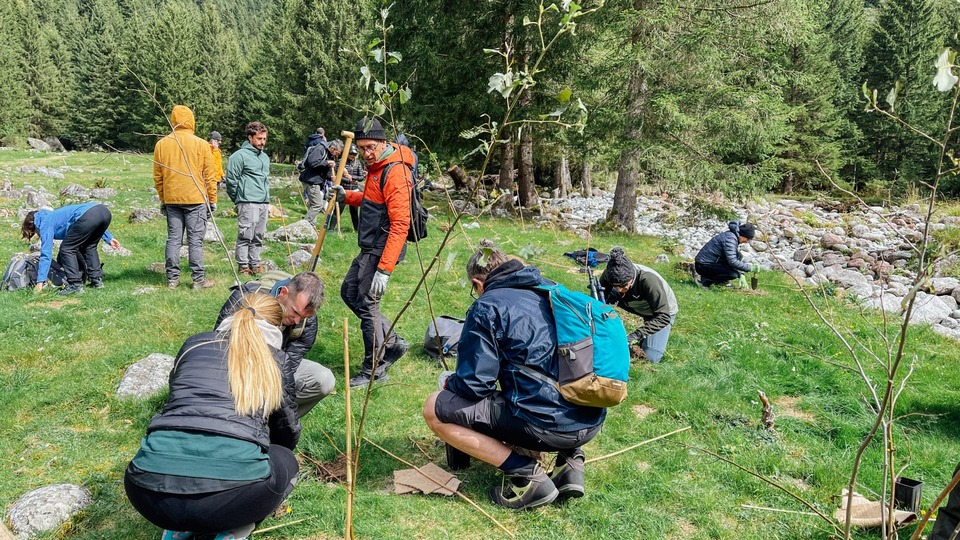
Reducing your company’s environmental impact: where to begin

A company’s environmental impact is the sum of all the effects that its activities have on the environment. These can include greenhouse gas (GHG) emissions, including CO2, the consumption of natural resources, the production of waste and much more.
Regardless of their size and sector, it is increasingly important for all companies to take action to reduce their environmental impact. Every company is called upon to embark on a path of corporate sustainability and become a leader in the ecological transition, and there are many reasons for this. The effects of climate change are becoming increasingly concrete: more frequent and intense extreme weather events are putting people, infrastructure and entire economic sectors at risk, generating rising costs for the community and businesses.
At the same time, consumer awareness is changing: there is growing trust in companies that demonstrate a concrete commitment to reducing their impact and that integrate sustainability into their strategies. Added to this is the regulatory framework: European and national institutions require companies to measure, report and reduce their emissions and environmental impact, making sustainability an essential requirement for remaining competitive.
Many companies have therefore defined an environmental CSR (Corporate Social Responsibility) strategy to achieve their ESG (environmental, social, and corporate governance) objectives and improve their performance through actions to reduce environmental and social impacts and by introducing criteria of transparency and inclusiveness in the management of the company. The commitment and results achieved are then shared with investors, customers, and employees through specific documents such as the Sustainability Report.

Why reducing corporate environmental impact is beneficial
For companies, investing in sustainability and reducing corporate environmental impact creates a more secure future, not only for the planet and future generations, but also for the organisation itself.
According to a recent ISTAT survey in Italy, 66.5% of manufacturing companies stated that they had committed to sustainability actions during 2022. Other research also points to a clear trend: 85% of companies increased their investment in sustainability in 2024, according to research published by Deloitte.
Finally, it cannot be ignored that for consumers, the issue of sustainability is becoming decisive in their assessment of brands and their products and services. A survey by Confindustria in collaboration with IPSOS (2022) shows that 80% of Italian consumers prefer “green companies” or “sustainable companies” in their purchasing choices.
There are many advantages for companies that choose to invest in an environmental responsibility strategy.
1. Economic: reducing energy and material consumption means saving money. Over time, green investments pay for themselves in efficiency and innovation.
2. Reputational: a sustainable company is perceived as more reliable, strengthening its bond with customers and communities.
3. Regulatory: with CSRD and the European Sustainability Reporting Standards (ESRS), transparency on environmental data is a legal requirement for thousands of companies. Acting early reduces the risk of non-compliance and lowers the costs of possible future audits.
4. Market and investors: companies that publish credible sustainability reports attract funding and partnerships more easily.
5. Employees and talent: sustainability increases the sense of belonging and attractiveness to younger generations.

What do we mean by a company’s environmental impact?
It is common to think of corporate environmental impact purely in terms of greenhouse gas emissions, such as carbon dioxide. In reality, this is only part of a wider picture. Environmental impact encompasses parameters related not only to climate but also to natural resources, biodiversity, ecosystems, and people and society.
Reducing atmospheric emissions remains a central goal in tackling climate change, and the GHG Protocol provides a key reference here. It classifies emissions into three categories – Scopes 1, 2 and 3 – enabling companies to measure them clearly and act accordingly. Emissions can stem from numerous activities: industrial processes, freight and passenger transport, farming, logistics, and energy consumption from fossil fuels.
Yet environmental impact goes far beyond emissions. It also includes water use and pollution, non-recycled waste production, soil degradation and habitat loss, with direct consequences for biodiversity. Other forms of pollution, such as noise and light pollution, must also be considered. Finally, a company’s impact extends across the entire supply chain, from sourcing decisions to the full life cycle of its products or services.
While the most critical areas vary by sector, transport, energy, and production remain the key focus. To assess their impacts and define ESG strategies, companies can rely on several internationally recognised tools and standards:
-
ISO 14001 – overall environmental impact management.
-
ISO 14067 – carbon footprint of products.
-
Life Cycle Assessment (LCA) – measures the life cycle impacts of products/services.
-
Science-Based Targets Initiative (SBTi) – sets emission reduction commitments in line with the Paris Agreement.
-
ESRS – European Sustainability Reporting Standards – introduced under the CSRD (Corporate Sustainability Reporting Directive), requiring detailed ESG reporting.

Practical strategies for more sustainable companies
Companies can take many measures to reduce their environmental impact and assist in addressing the ongoing climate and ecological crisis. A personalised reduction plan is vital, concentrating on the most relevant areas for each organisation. Strategies may include actions to enhance:
Energy efficiency
Reducing consumption is the initial step towards sustainability. Efficient technologies – such as LED lighting, smart monitoring systems, and low-energy machinery – combined with everyday best practices decrease both costs and environmental impacts.
Renewable energy
The energy transition means shifting away from fossil fuels. Installing solar panels or contracting renewable energy supplies significantly cuts GHG emissions.
Sustainable waste management
Reduction, reuse and recycling are key. Minimising waste, redesigning packaging and recovering materials help lower impacts and promote circular economy models.
Corporate mobility
Business travel and freight are major emission sources. Carpooling, electric fleets, remote working and sustainable commuting incentives for staff reduce both costs and ecological footprint.
Digitalisation and dematerialisation
Replacing paper processes with digital solutions not only cuts paper use but also boosts organisational efficiency and innovation.
Monitoring tools and technologies
Tracking and measuring impacts is crucial for improvement. ESG software, environmental management systems and certifications help set tangible goals and communicate progress transparently.

Engaging employees and stakeholders in the green transition
Companies are made up of people. For this reason, every move towards greater environmental sustainability must include raising awareness and training employees. This ensures that investments deliver value, that individual behaviours support corporate goals, and that decision-making across the organisation adopts an environmentally and socially responsible perspective.
Firms can launch participatory initiatives such as challenges, green task teams, or awareness-raising events. Many WOWnature partners involve employees and clients in tree-planting events, linking sustainability goals with shared experiences.
Equally important is communicating achievements through sustainability reports, ESG disclosures and authentic CSR initiatives. This avoids greenwashing risks and builds trust among clients, partners and communities.
Success stories: companies making a difference
Many companies have chosen to work with WOWnature to protect forests and nature, supporting reforestation and conservation projects in Italy and abroad. Since 2018, over 500 businesses have partnered with Etifor to measure and reduce their corporate environmental impacts while restoring habitats valuable to both biodiversity and people. Some of these stories were featured in the TV series Opera Verde, broadcast on Rai 3 in 2024 and now available on RaiPlay. Brands such as Pasta Sgambaro, Levico and Molino Pordenone were among the companies showcased, sharing their environmental responsibility journeys with WOWnature and Etifor.
Where to begin: first steps for every company
With support from Etifor and WOWnature, companies can follow a structured path, starting with an assessment of corporate or product environmental impacts using internationally recognised standards. At this stage, it is advisable to rely on expert consultants who can interpret data, navigate regulations such as CSRD and ESG standards, and turn challenges into opportunities for improvement.
Alongside these measures, companies can already take concrete steps by supporting certified reforestation and biodiversity conservation projects with WOWnature. Creating new forests in Italy or abroad generates value for local communities, engages employees in meaningful experiences, and strengthens a company’s green reputation.
Start a corporate environmental resposibility path
Find out how WOWnature can help your company to become more sustainable and communicate its effort in a clear and effective way.
SHARE
Other posts


Updates from Campo dei Fiori Park


What role do trees play in relation to water?

Sustainable gifts: sustainable gift ideas that respect the environment




